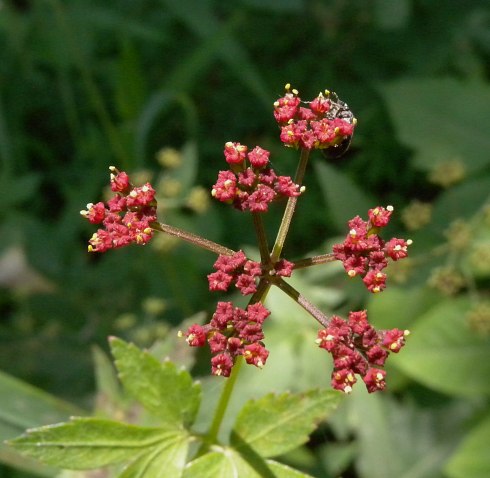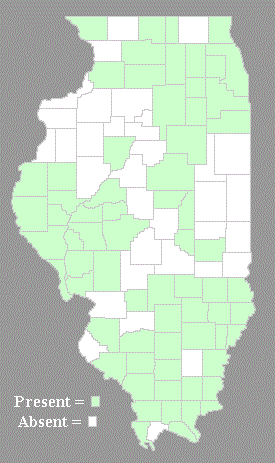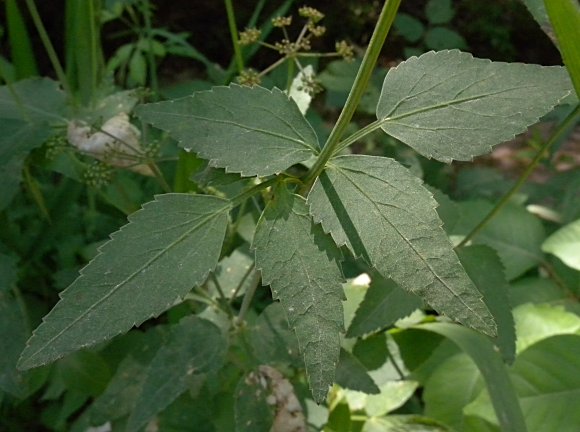
The upper stems terminate in compound umbels of flowers that span 1-3" across. Each compound umbel has 6-12 rays (floral stalks) that terminate in small umbellets of flowers; the rays are light green to pale purplish green, grooved along their upper sides, and glabrous. Each umbellet has 5-12 rays about 4 mm. long that terminate in individual flowers. Each flower is about 2-3 mm. across, consisting of 5 maroon (reddish purple) petals, a short green or purplish green calyx with 5 teeth, 5 stamens, and a 2-celled ovary with a pair of styles. The tips of the petals are strongly incurved toward the center of each flower. Underneath the compound umbel and each umbellet, there are 0-3 floral bracts. If these floral
 bracts are present, that are linear-lanceolate in
shape, small in size, and early-deciduous. The blooming period
occurs from mid-spring to early summer, lasting about 3-4 weeks.
Afterwards, the flowers are replaced by small fruits about 4 mm. in
length that are broadly ellipsoid-oblongoid in shape and strongly
winged. Each fruit consists of a pair of carpels that each enclose a
single seed. The carpels can be blown about by the wind to a limited
extent. The root system consists of a taproot.
bracts are present, that are linear-lanceolate in
shape, small in size, and early-deciduous. The blooming period
occurs from mid-spring to early summer, lasting about 3-4 weeks.
Afterwards, the flowers are replaced by small fruits about 4 mm. in
length that are broadly ellipsoid-oblongoid in shape and strongly
winged. Each fruit consists of a pair of carpels that each enclose a
single seed. The carpels can be blown about by the wind to a limited
extent. The root system consists of a taproot.Cultivation: The preference is full sun to light shade, mesic to dry-mesic conditions, and practically any kind of soil, including those that contain clay-loam and rocky material.
Range & Habitat: The native Purple Meadow Parsnip occurs primarily in the southern half of Illinois, where it is uncommon, while in the northern half of the state it is rare or absent. It should be noted that the available distribution map does not distinguish between the two varieties of this species, Thaspium trifoliatum trifoliatum (Purple Meadow Parsnip) and Thaspium trifoliatum flavum (Yellow Meadow Parsnip). The latter variety is the more common of the two and its range extends further north. Habitats for both varieties consist of rocky upland woodlands, rocky bluffs, upland oak savannas, woodland borders and openings, prairies, streambanks, and roadsides.
Faunal Associations: The nectar and pollen of the maroon flowers attract primarily flies and beetles. Robertson (1929) observed a dance fly (Empis loripedis) sucking nectar from the flowers, while the author (or content partner) of this website observed an unidentified beetle feeding on the pollen. The caterpillars of two butterflies, Papilio polyxenes asterias (Black Swallowtail) and Papilio joanae (Ozark Swallowtail), feed on the foliage of Thaspium trifoliatum (Meadow Parsnip). Although the latter butterfly has not been observed in Illinois thus far, it has been found in neighboring Missouri. An aphid, Aphis thaspii, sucks juices from the umbels of the flowers.
Photographic Location: Along a roadside in southern Illinois.

Comments: Because of its striking maroon flowers, Purple Meadow Parsnip can be easily distinguished from other similar species in the Carrot family. This does not apply to the other variety of this species, Yellow Meadow Parsnip (Thaspium trifoliatum flavum), which has yellow flowers. In general, Meadow Parsnip (Thaspium trifoliatum) is very similar to Zizia aurea (Golden Alexanders) and Zizia aptera (Heart-Leaved Alexanders). However, the latter two species have fruits that are ribbed, rather than strongly winged, and the central flowers of their umbellets are sessile (or nearly so). Unlike Meadow Parsnip and Heart-Leaved Alexanders, the common Golden Alexanders has compound basal leaves and its alternate leaves are often ternately trifoliate. It also prefers habitats that are more moist.